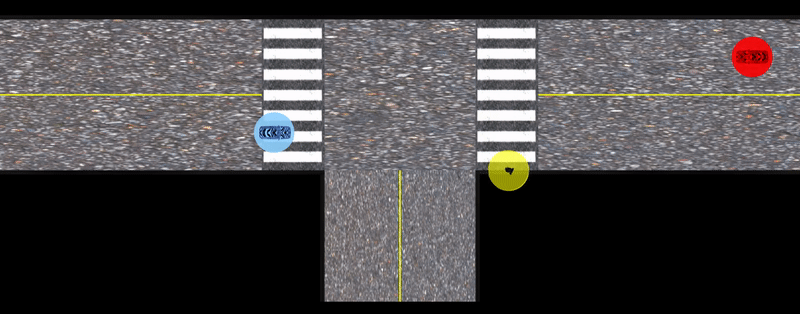A package for solving constrained dynamic games written in Julia. Currently, the following methods are implemented with a common interface:
ALGAMES (Augmented Lagrangian Games Theoretic Solver): A fast solver for constrained dynamic games that features:
- General nonlinear cost functions
- General nonlinear state and input constraints
This package also features:
- Several autonomous driving environments (ramp merging, intersection crossing, etc.)
- A Model Predictive Control (MPC) implementation of ALGAMES
- Plotting and visualization tools
All methods utilize Julia's extensive autodifferentiation capabilities via ForwardDiff.jl so that the user does not need to specify derivatives of dynamics, cost, or constraint functions.
To install ALGAMES.jl, in Atom, run the following from the Julia REPL:
Pkg.add(PackageSpec(name="TrajectoryOptimization", rev="v1.3"))Clone the repository:
git clone https://github.com/RoboticExplorationLab/ALGAMES.jlActivate the project in Atom, instantiate the package:
(ALGAMES) pkg> instantiate
using ALGAMESTo run a simple example of a 2-player 2D double-integrator:
using ALGAMES
using LinearAlgebra
using StaticArrays
using TrajectoryOptimization
const TO = TrajectoryOptimization
# Discretization info
tf = 3.0 # final time
N = 41 # number of knot points
dt = tf / (N-1) # time step duration
# Instantiate dynamics model
model = DoubleIntegratorGame(p=2)
n,m,pu,p = size(model)
T = Float64
x0 = @SVector [-0.50, -0.50, # x
0.10, -0.10, # y
0.50, 0.40, # xdot
0.00, 0.00] # ydot
xf = @SVector [ 0.50, 0.50, # x
-0.10, 0.10, # y
0.40, 0.30, # xdot
0.00, 0.10] # ydot
# Define a quadratic cost for each player
diag_Q = [SVector{n}([1., 0., 1., 0., 1., 0., 1., 0.]), # Player 1 cost
SVector{n}([0., 1., 0., 1., 0., 1., 0., 1.])] # Player 2 cost
Q = [0.1*Diagonal(diag_Q[i]) for i=1:p] # Players stage state costs
Qf = [1.0*Diagonal(diag_Q[i]) for i=1:p] # Players final state costs
# Players controls costs
R = [0.1*Diagonal(@SVector ones(length(pu[i]))) for i=1:p]
# Players objectives
obj = [LQRObjective(Q[i],R[i],Qf[i],xf,N) for i=1:p]
# Build problem
actor_radius = 0.08
actors_radii = [actor_radius for i=1:p]
# Create constraints
conSet = ConstraintSet(n,m,N)
con_inds = 2:N # Indices where the constraints will be applied
# Add collision avoidance constraints
add_collision_avoidance(conSet, actors_radii, model.px, p, con_inds)
# Define the problem
prob = GameProblem(model, obj, xf, tf, constraints=conSet, x0=x0, N=N)
# Specify the solver's options
opts = DirectGamesSolverOptions{T}()
solver = DirectGamesSolver(prob, opts)
solve!(solver)Notebooks with more detailed examples can be found here, including all the examples from our RSS 2020 paper. Among these examples we solve a ramp merging problem and an intersection crossing problem:
We also perform a Monte Carlo analysis of ALGAMES to evaluate the robustness and speed of the solver to noise in the initial condition.




